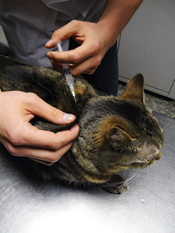Cat diabetes is a concern to more cat owners than you probably realized. Though this disease is more common in humans, animals get it, too. Get the facts!
 Here’s what the ASPCA says about cat diabetes:
Here’s what the ASPCA says about cat diabetes:
Diabetes in cats is a complex disease caused by either a lack of the hormone insulin or an inadequate response to insulin. After a cat eats, her digestive system breaks food into various components, including glucose—which is carried into her cells by insulin. When a cat does not produce insulin or cannot utilize it normally, her blood sugar levels elevate. The result is hyperglycemia, which, if left untreated, can cause many complicated health problems for a cat.
Put more simplistically, the cause of cat diabetes is sugar or glucose found in the blood.
The level of blood sugar in the body or the animal is kept under control by hormone insulin, which the pancreas produces. When the pancreas doesn’t produce enough insulin, diabetes is to blame.
The symptoms of cat diabetes will vary. The most common symptoms include an increase in urine and an increase in thirst. Other symptoms of feline diabetes include a loss of appetite, weight loss, and a poor coat. An increase in thirst is easy to detect, as you can easily notice the water dish empty throughout the day.
If you don’t get your cat treated for feline diabetes immediately, the cat will eventually become inactive, vomit on a regular basis, and eventually fall into a coma. On the other hand, if you get the diabetes treated in time, the cat will more than likely lead a normal and healthy life. Keep in mind that treatment doesn’t happen overnight – it takes time and dedication.
Cats that have feline diabetes will need to be given food at the same time every day. They should be prevented from going outside as well. If your cat has diabetes, you’ll need to give him insulin shots once or twice or a day. Once your veterinarian checks your cat, he will tell you how many shots and how much insulin you need to give your cat.
Before you give your cat his insulin shot, you should always make sure that he has some food first. If he hasn’t eaten and you give him a shot anyway, he could end up with a hypoglycemic shock. This can also occur from too much insulin as well. A hypo can be really dangerous, and should be avoided at all costs. If your cat gets a hypoglycemic shock and you aren’t around, he may end up dying.
If you have to give insulin shots to your cat due to feline diabetes, you should always keep a watchful eye on him after you have administered the shot. After your cat has been on insulin for a period of time, your vet may reduce the amount of insulin. Even though he may have to stay on insulin the rest of his life, he will lead an otherwise healthy life.
How is your cat doing? Here’s a great checklist of the symptoms of cat diabetes.
